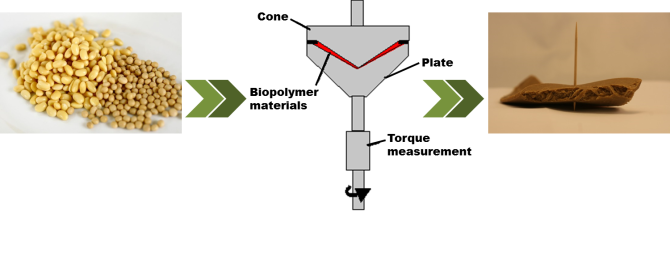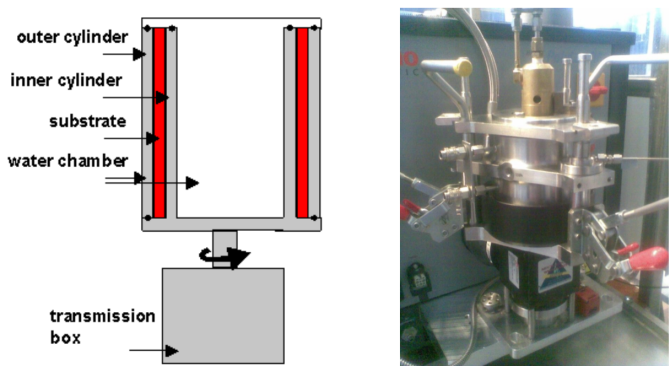
Shear Cell Story
The shearcell is based on the principles of a rheometer using well-defined flow field for structuring biopolymer materials. In the shear cell these shear forces are applied to the materials by a rotating plate and a stationary cone.
The shearing process has a huge potential for many innovative and sustainable food applications as described in our research topics.
Research topics
In case of wheat-flour, the shearing process induces separation of components and when shear forces are applied to a soy based or dairy material a fibril meat like structure can be obtained.
Shear cell - development
Here you can read about the history of the shear cell and how it is developed in cooperation with the mechanical workshop.

Shear Cell cone-plate
To understand the effect of plain shear we have developed a shear cell. The top and bottom of the shearing device is designed as a cone-and-plate geometry with an angle of 2.81. Due to this angle, the shear rate between the cone and plate is constant throughout the cell. The research done with the 1st cone/plate shear cell is very promising, but limiting in many ways. The 2nd shear cell we developed is much smaller and can be attached to the Brabender Do-Corder Drive unit, which operates by the Brabender Winmix Software. The software shows the development of the torque, temperature and speed in a graph. And it gives the opportunity to evaluate and compare different data-sets. The 3rd design of the shear cell was equipped with a pneumatic system to open/close the shear cell. The 4th design had a smaller volume and it was possible to vary the shear rate within the cell by (ex)changing the angle of the cone. The combination of shear and elevated temperature was required to obtain the ‘meat-like’ structure formation of plant based materials like soy. Therefore a 5th shear cell was designed to operate at high temperatures (above 100°C) within a closed pressurized system to avoid evaporation of water. The 6th and latest developed shear cell is now being tested in our laboratory. This improved and more compact model is also suitable for high temperatures and more designed towards practical application, for example as standard equipment in other laboratories.

Shear cylinder - development
The Shear Cylinder (a-)centric was used to study the effect of either constant or transient shear flow. This device is based on common concentric cylinder rheometer concept, also known as Couette device. With the outer cylinder held fixed, the inner cylinder rotates clockwise and is connected to the Brabender Do-corder platform with an interface and controller unit (PL 2100, Brabender Measurement and Control Systems, Duisburg, Germany) to measure the torque required to maintain a constant angular velocity of the rotating cylinder. The position of the outer cylinder (stator) can be varied by a gap-setting device. The cell can be used either with a concentric annulus to apply a simple shear flow at a constant rate or as an a-centric annulus to provide a combination of transient shear and elongational flows. Volume of mixer bowl varies between 32.5 - 60.0 ml.

The Shear Cylinders mini was developed to perform heating and shearing simultaneously while avoiding water evaporation. It was made from titanium. The volume of the shearing device is 18 ml. The inner cylinder of the shearing device rotates with a mechanical stirrer (type 2041, Heidolph Instruments, Schwabach, Germany) and the cell is heated by placing it in a water bath.